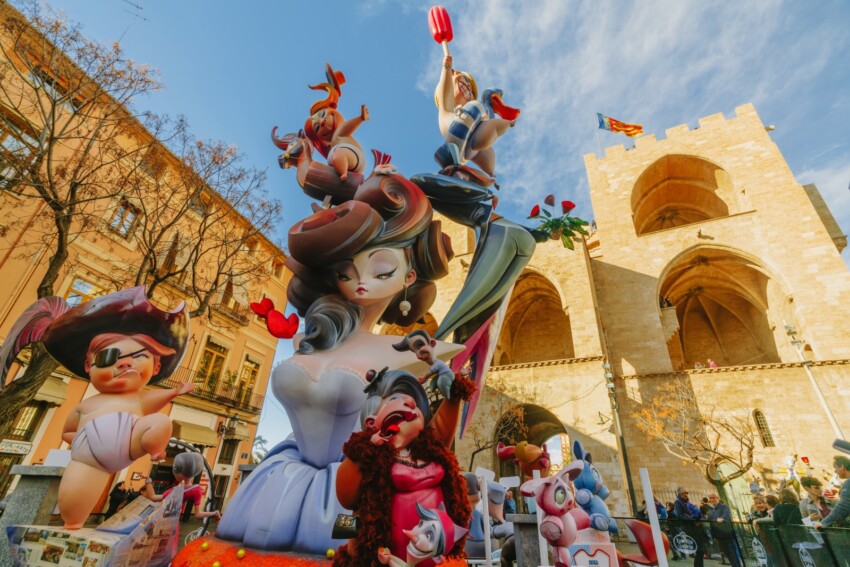

Las Fallas de San José, commonly called Las Fallas, is the most important event in the city of Valencia in which all Valencians participate with enthusiasm, passion and pride. It is a festival of epic proportions, like few others you will see in the world, and it has a profound meaning for the Valencians, which is why it is so much loved; in recent years it has been declared a Unesco World Heritage Site.
Las Fallas, which give the festival its name, are huge papier-mâché and wooden puppets that represent fictional characters or local and international public figures in a satirical way. They are monumental constructions, the most impressive reaching up to 20 metres in height, and Valencians work on their preparation for a whole year. During the festivities they are assembled, left on display in the streets and squares of the city and finally burnt in a blaze of lights, music and fireworks. No less spectacular than these enormous puppets are the typical costumes worn by the Valencian women during the festival.
At the base of the puppets are figurines called ninots. Each year only one ninot, chosen by popular vote, is spared from the flames and enters by right into the Fallero Museum, a highly original museum that you absolutely must visit during your holiday in Valencia. The collection of ninots represents a fascinating excursus into the history of this very special tradition.
Las Fallas week is the busiest tourist period in Valencia and hotels usually sell out. If you want to visit the city and participate in this extraordinary event, it is strongly recommended to book well in advance.

The festivities take place over a fairly long period, from the last Sunday in February to 19 March, the day of San José, according to a script dictated by tradition that includes well-defined roles and situations (such as the Fallera Mayor, the queen of the fiesta, and the mascletas, daily firework displays of deafening firecrackers).
The climax of the festivities is between the 15th and 19th of March and the most exciting moment is the night between the 18th and 19th, known as the nit del foc, during which the Valencians’ passion for fireworks explodes (one could say literally!), with firecrackers thrown in the streets and a grandiose final firework display.
The following night, the sky is once again lit up, this time by the fires that burn down the huge puppets of the festival. Only one is spared, and it will be exhibited in the Museo Fallero.
The final week of Las Fallas is a high season for tourism in Valencia, so it is recommended to book flights and hotels well in advance so as not to risk a sell-out.

The Museo Fallero is a place dedicated to the celebration and preservation of the Fallas tradition, one of the city’s most important and characteristic festivities. Located in the neighbourhood of Monteolivete, near the City of Arts and Sciences, the museum collects and exhibits the ‘ninots‘, the papier-mâché figures that are part of the giant Fallas monuments. Every year, these structures are burnt as part of the celebrations, but the museum houses the ‘ninots indultats‘, i.e. those that, thanks to popular vote, are spared from the fire.
This collection of figures began in 1934 and is enriched each year with new pieces, offering an overview of the artistic and technical evolution of this form of craftsmanship. The ‘ninots’ often depict satirical or humorous scenes, with caricatures of public figures, political figures, or everyday life situations, creating a link between popular art and contemporary society.
To visit the Museo Fallero is to immerse oneself in Valencian history and culture, understanding the profound significance of the Fallas for the city. In addition to the ‘ninots’, the museum displays posters, photographs and other objects related to the Fallas, telling a story that goes beyond the festive aspect, exploring the link between tradition, art and local identity.
The Museo Fallero can be visited free of charge with the Valencia Tourist Card.
City Card allow you to save on public transport and / or on the entrances to the main tourist attractions.
